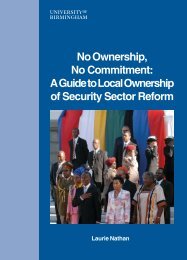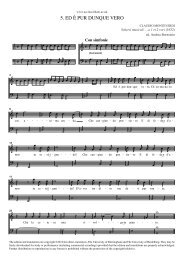Birmingham Environment for Academic Research - University of ...
Birmingham Environment for Academic Research - University of ...
Birmingham Environment for Academic Research - University of ...
- No tags were found...
Create successful ePaper yourself
Turn your PDF publications into a flip-book with our unique Google optimized e-Paper software.
Evaluation <strong>of</strong> de<strong>for</strong>mation mechanisms in single point incremental <strong>for</strong>ming SPIF (SingleMany <strong>of</strong> the previous investigations have focused on an analysis <strong>of</strong> de<strong>for</strong>mation mechanics <strong>of</strong> SPIFthrough experimental investigations or by using the finite element (FE) method. The work, however,is contradictory with different views on the detailed de<strong>for</strong>mation modes. From a review <strong>of</strong> the literature,it was suggested that stretching and thinning are the dominant modes <strong>of</strong> de<strong>for</strong>mation. Conversely,experimental measurements from some investigations indicated that high values <strong>of</strong> transverseshear are present through the thickness. Numerical methods, <strong>for</strong> example FE modelling, permita detailed study <strong>of</strong> complex de<strong>for</strong>mation behaviour and as experimental observations <strong>of</strong> through-thickness phenomena are extremely difficult, modelling <strong>of</strong> the SPIF processes becomes an essential tool.The aim is to evaluate the presence <strong>of</strong> through-thickness shear de<strong>for</strong>mation through a multi-level FE approach and to investigate howit is affected by the process parameters. Additionally, improve the geometrical accuracy without affecting the process flexibility.Using a dual-level FE modelling approach, a significant value <strong>of</strong> through-thickness shear in two planes is predicted. One <strong>of</strong> theseplanes is perpendicular to the tool movement and the other is parallel to the tool direction. This suggests that this shear strain couldbe a major contribution to the increase in the <strong>for</strong>ming limit <strong>of</strong> the material in this process. Simple strategies such as adding a backingplate, using a kinematic supporting tool and tool path optimization result in considerable improvement in the geometrical accuracy <strong>of</strong>the final product.Khamis EssaSchool <strong>of</strong> Mechanical EngineeringPage 22








